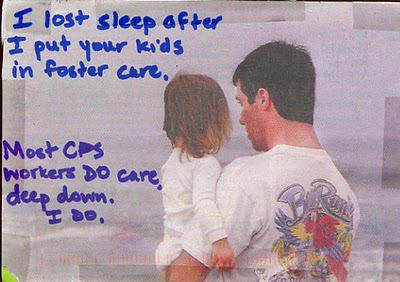One of the regular blogs I subscribe to in my RSS feeder is PostSecret. If you haven’t heard of PostSecret yet, it’s a blog hosted by Frank Warren (who has also written numerous books), and according to his web site, PostSecret is “a community art project where people mail in their secrets anonymously on one side of a postcard.” Each Sunday he publishes “Sunday Secrets” a blog post of postcards that people send in to him.
The internet is the perfect environment for this kind of secret confessional. I read Sunday Secrets each week because I know I’ll find at least one card that really speaks to me. This past week there were two of them that as a child welfare scholar I found moving.
The first one, pictured above, spoke to me because I think that people outside the field believe that child protection workers enjoy taking kids away from their parents. While I am sure there are some punitive and cynical child protection workers – in fact I’ve met some and worked with some – I have never met a worker who finds pleasure in it. I have seen them express heartbreak over having to consider whether they need to remove a child from their parents. It is not an easy decision to make and I have to believe that if there comes a time when the worker does not agonize about whether the trauma of removing a child is worse than the trauma of leaving them there, then that is a sign that it’s time to put in for a transfer. It should never be a rote decision; even when using the “tools” of the trade – structured decision making forms and assessment checklists and the like – the decision to remove a child is often a mixture of art and science.
Because the other side of the coin might be represented in the postcard below. What I found sad about this postcard is that this person did not call social services on behalf of their nieces. This postcard leaves me with many questions. If the children were removed, would the author of the card be willing to take those kids? How involved is the extended family? Has the family been supportive of those children and the parents in the past or have all efforts failed? How long have the children been at risk?
The dilemma I have struggled with for a long time now is this: when we take a child away from their parents because we are afraid of their safety and well-being, then the state has made a promise that they will be treated better in another home. However, this is not being done very well. Foster care is not a substitute for a family. Institutions are often worse and many foster homes are merely small institutions. So the push in child welfare is to move the child to “permanency.” That means adoption. However, most of the kids do not get adopted. So where do we put our resources? Towards family preservation? Towards improving foster care? Towards tighter deadlines for termination of parental rights and adoption?
When I see this postcard above, I wonder why this person chose to do nothing and hope that some day, someone would call child protective services for them.


Thanks for sharing these. I also find the second one quite hard to understand but if there’s one thing I have learnt it’s that family dynamics can be very… different in different families and ‘reporting to social services’ can be quite a dramatic step to take – but hoping someone else will is less likely to break down some of the intra-family taboos. Of course it shouldn’t be like that and protection of children should come above all things.
Incidently, all the children I have fostered have returned either to their mothers or close family.
As resources need to be rationed, my own thoughts (and I have never worked in childrens’ services so this is just a ‘gut’ laypersons’ view and my view as a foster carer – rather than as a social worker) is that if anything, the priority has to be to preventative work but that invites more risk.
As a former child welfare worker I really hate to sound cynical but I often wonder if it is even possible to create a system that works. I really believe in preventative work; however I’ve come across enough cases where the kin or extended family is not a good resource for the child or children and sometimes the kids are safer in foster homes with strangers. So while in theory I would give preference to family, it isn’t clear that that is always the best for the kids. That’s why it makes it so wrenching, and that’s why the first postcard struck such a chord with me.
I wonder what the threshhold level is when it comes to deciding when to call social services. I’ve had friends call me about their extended family members, asking if they can report on them anonymously; I’ve also had friends who have had the experience of having angry ex-partners report them to social services. I can only imagine that calling to report a family member must be agonizing.